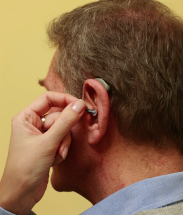How to make your practice more accessible to patients with hearing loss

One in six people in the UK are now living with hearing loss. Due to a rapidly ageing population this will have increased to one in five of us by 2035.
Hearing loss is a major public health issue, with links to social isolation, poorer employment prospects, diminished self-confidence, mental health problems and depression. Hearing loss is even linked to dementia – a patient is five times more likely to develop dementia if they have severe hearing loss, three times more likely with moderate hearing loss, and twice as likely with mild hearing loss.
By 31 July 2016, all health and social care services will be required to meet the Accessible Information Standard, requiring that all people with hearing loss, sight loss or learning disabilities receive information in formats that they can understand, and that they receive appropriate support to help them communicate. The CQC may also look at this during inspections. Here are some easy ways to make your practice more accessible for patients with hearing loss:
1. Allow patients to book appointments without relying on telephones. For obvious reasons, this can make it difficult for patients with hearing loss. Perhaps consider establishing a dedicated email address or SMS service to book appointments.
2. Record and flag patients’ communication needs on care records. A note on the record will allow staff to be prepared when the patient contacts the practice. For example, they will know that they may need to book the patient longer appointments if their hearing loss means they need more time to discuss issues, or book a British Sign Language interpreter if needed.
3. Make patients with hearing loss aware when it’s their turn to see the doctor. Lots of people with hearing loss miss appointments every day simply because they hadn’t heard their name being called out in the waiting room. NHS England estimates that this problem alone costs the NHS at least £14 million every year. Visual display systems or vibrating flashing pagers can help alert patients when their appointment is without relying on hearing. Working hearing loops that reduce background noise and transmit signals that can be picked up by hearing aids are also useful to help those with hearing aids communicate with receptionists and other members of staff.
4. In the consultation, there are some easy ways to allow patients with hearing loss to fully understand you. Face the patient in a well-lit room and don’t cover your mouth, which is particularly beneficial for people who lipread. Speak clearly at a normal volume as shouting can be uncomfortable for those who wear hearing aids.
5. Push your patients to get hearing aids if you think they need them. Whether it’s due to the perceived stigma about wearing hearing aids, or simply because it’s seen as an inevitable part of ageing, many patients with hearing loss miss out on the advantages hearing aids bring, and wait an average of ten years before seeking help. Wearing hearing aids can reconnect patients with the social world, improve their ability to communicate – and, of course, enable them to enjoy the same access to healthcare as everyone else.
If you are keen to take it a step further, a variety of training courses are available, from deaf awareness courses to sign language training and you can find further guidelines for GPs here.
Tom Bailey is a Research and Policy Officer at Action on Hearing Loss









